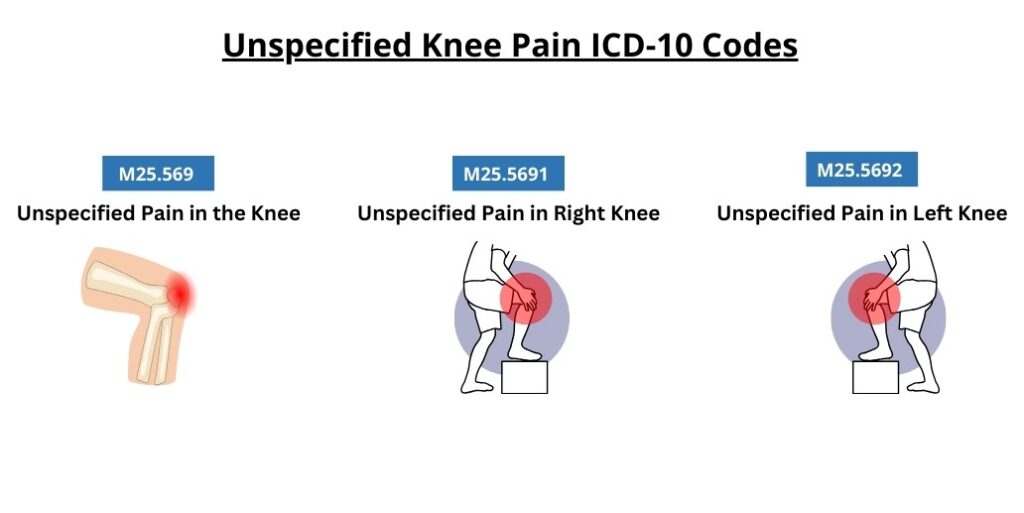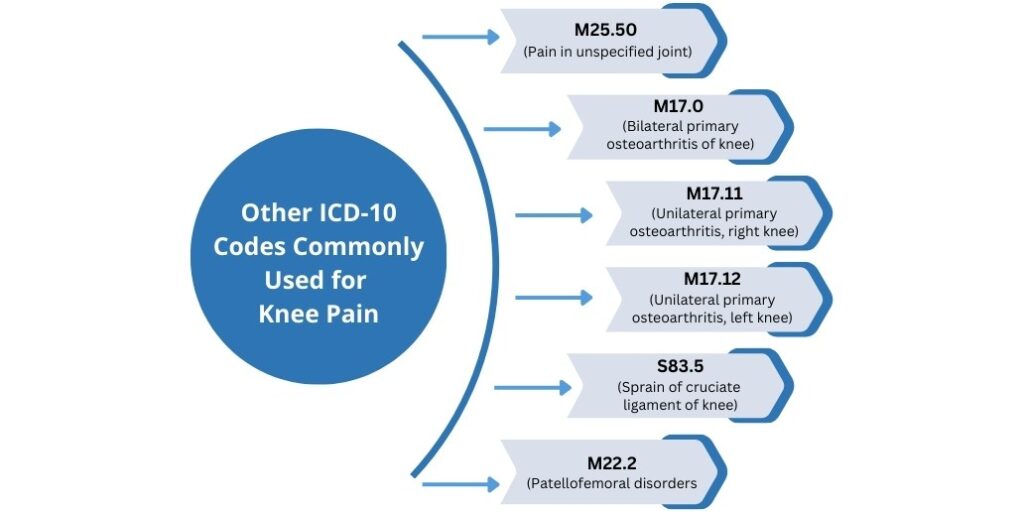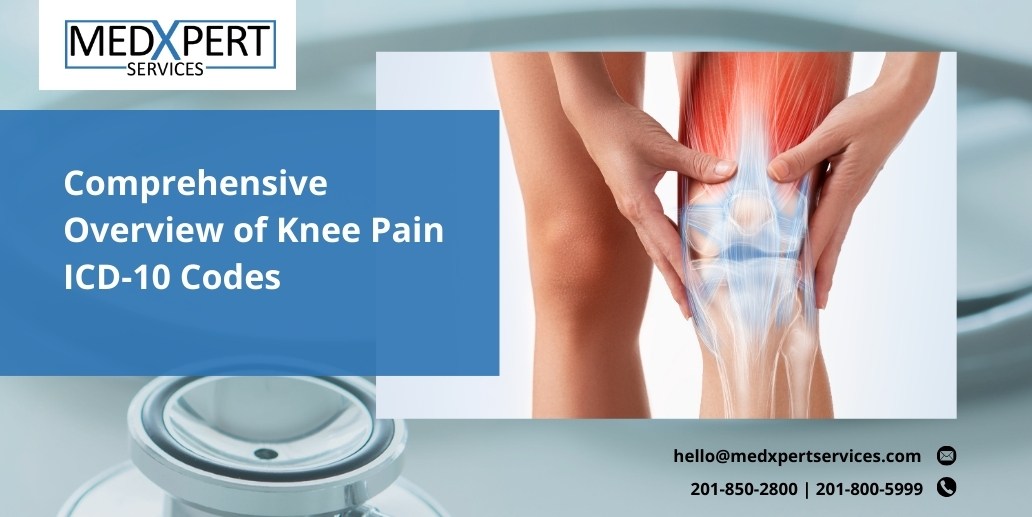Knee pain is a prevalent issue that impacts countless individuals globally, often necessitating medical intervention and precise documentation for effective treatment and insurance reimbursement. The International Classification of Diseases, Tenth Revision (ICD-10) offers a standardized framework for coding various health conditions, including knee pain.
Mastering ICD-10 codes for knee pain is essential for healthcare providers and medical billing professionals to ensure accurate diagnosis reporting and streamline reimbursement processes. Proper coding not only facilitates effective treatment planning but also plays a crucial role in securing timely and appropriate payments from insurance companies.
In this blog, we will explore the essential ICD-10 codes for knee pain, providing a valuable resource for healthcare professionals and medical billers aiming to optimize patient care and financial operations.
Knee Pain ICD 10 Codes
The ICD-10 code M25.56 is specifically used to identify pain in the knee. This code falls under the category of “Other joint disorders, not elsewhere classified,” which encompasses various joint-related issues that do not have a more specific diagnosis code.
Accurate use of M25.56 is critical for healthcare providers as it enables clear communication of the patient’s condition to insurers and other medical professionals. By coding knee pain accurately with M25.56, medical practitioners can ensure that the patient’s treatment plan is well-documented and that the services provided are appropriately reimbursed.
This not only enhances the quality of patient care but also streamlines the administrative processes involved in medical billing and insurance claims.
Unspecified Knee Pain ICD-10 Codes
When documenting knee pain, there are times when the exact cause of the pain may be unclear, necessitating the use of unspecified ICD-10 codes. These codes are essential for healthcare providers to indicate the presence of pain without committing to a specific diagnosis, allowing for accurate record-keeping and ensuring that patients receive the appropriate attention and treatment.
The ICD-10 codes M25.569, M25.5691, and M25.5692 are used to denote unspecified knee pain, providing clarity and specificity about which knee is affected when the cause of the pain remains undetermined.

M25.569: Unspecified Pain in the Knee
This code is used when there is pain in the knee, but the specific knee (right or left) is not identified, and the underlying cause is unknown. It is a general code applicable to any unspecified knee pain that does not fall under more specific categories.
M25.5691: Unspecified Pain in Right Knee
Use this code when the patient experiences pain specifically in the right knee, but the exact cause of the pain has not been determined. This code helps in isolating the pain in the right knee, facilitating targeted examination and treatment.
M25.5692: Unspecified Pain in Left Knee
This code is designated for cases where the pain is located in the left knee, with no known cause. It allows healthcare providers to document the specific location of the pain, aiding in focused diagnostic efforts and therapeutic interventions.
ICD 10 Code for Pain in Right Knee
The ICD-10 code M25.561 is designated for pain, specifically in the right knee. This code falls under the broader category of “Other joint disorders, not elsewhere classified” and is crucial for accurately documenting and communicating the exact location of a patient’s knee pain.
Utilizing M25.561 ensures that the pain is precisely attributed to the right knee, which is vital for developing an effective treatment plan. Accurate coding with M25.561 aids healthcare providers in monitoring the patient’s condition, facilitating appropriate diagnostic tests, and tailoring interventions.
Additionally, this precise documentation is indispensable for insurance purposes, ensuring that claims are processed efficiently and that providers receive proper reimbursement for their services.
ICD 10 Code for Pain in Left Knee
The ICD-10 code M25.562 is used to indicate pain located in the left knee. This code, also under the category of “Other joint disorders, not elsewhere classified,” plays a significant role in the clear and precise documentation of a patient’s knee pain.
By employing M25.562, healthcare providers can specifically identify and treat pain in the left knee, ensuring that all medical records reflect the accurate site of discomfort. This specificity is crucial not only for the effective management and treatment of the condition but also for insurance and billing purposes.
Proper use of M25.562 allows for streamlined claims processing, facilitating timely and appropriate reimbursement for healthcare services provided.
Other ICD-10 Codes Commonly Used for Knee Pain
In addition to the specific codes for right and left knee pain, there are several other ICD-10 codes that are frequently used to document various conditions and injuries related to knee pain.
These codes help healthcare providers accurately describe the nature and location of the knee pain, facilitating effective treatment and ensuring proper insurance reimbursement.

M25.50 (Pain in unspecified joint): Used when pain is present in a joint, but the specific joint is not identified. This code is applicable when the exact location of the joint pain is uncertain, necessitating further investigation.
M17.0 (Bilateral primary osteoarthritis of knee): Indicates primary osteoarthritis affecting both knees. This code is crucial for documenting cases where degenerative joint disease impacts both knees, leading to comprehensive treatment plans aimed at managing symptoms bilaterally.
M17.11 (Unilateral primary osteoarthritis, right knee): Used for primary osteoarthritis that is specifically in the right knee. This code helps in distinguishing cases where osteoarthritis affects only the right knee, guiding focused therapeutic interventions.
M17.12 (Unilateral primary osteoarthritis, left knee): Designates primary osteoarthritis specifically in the left knee. This code is important for cases where osteoarthritis is confined to the left knee, facilitating precise treatment and management strategies.
S83.5 (Sprain of cruciate ligament of knee): Refers to a sprain injury to the cruciate ligament within the knee. This code is essential for documenting ligamentous injuries, which often require specific rehabilitative and sometimes surgical treatments.
M22.2 (Patellofemoral disorders): Used for disorders related to the patellofemoral joint involving the kneecap and femur. This code covers a range of conditions that affect the interaction between the patella and femur, often requiring specialized treatment to address issues like patellar tracking disorders or patellofemoral pain syndrome.
Knee Pain Billable ICD-10 Codes
For knee pain, several ICD-10 codes are considered billable, meaning they can be used for insurance claims and are recognized for reimbursement purposes. One such example is M25.562, which is indeed a billable code used to denote pain in the left knee. This code is specific enough to provide insurers with the necessary details to process claims accurately.
Similarly, M25.569, which indicates unspecified pain in the knee, is also billable. These codes help in documenting knee pain accurately, ensuring that healthcare providers are reimbursed correctly for their services while facilitating clear communication between medical professionals and insurance companies.
Clinical Information
Understanding the clinical aspects of knee pain is crucial for accurate diagnosis and effective treatment. Diagnosis code M25.562 is specifically used to indicate pain in the left knee. The causes of left knee pain can vary widely, from acute injuries to chronic conditions, and recognizing these causes is essential for providing appropriate care.
Common Causes of Left Knee Pain:
Ligament Sprains: Injuries to the knee ligaments, such as the ACL or MCL, are often caused by sudden twists or impacts.
Meniscus Tears: Damage to the cartilage that cushions the knee joint, frequently resulting from activities that cause forceful twisting or rotation.
Tendonitis: Inflammation of the tendons around the knee, usually due to overuse or repetitive strain.
Bursitis: Inflammation of the bursae, small fluid-filled sacs that reduce friction in the knee joint, often caused by repetitive movements or prolonged pressure.
Osteoarthritis: A degenerative joint disease that leads to the breakdown of cartilage, causing pain and stiffness in the knee.
Diagnosis and Treatment:
- Proper Diagnosis: It is essential to identify the underlying cause of knee pain and prevent complications.
Treatment Options:
- Rest, Ice, Compression, Elevation (RICE): Standard first aid measures for acute injuries.
- Medication: Pain relievers and anti-inflammatory drugs to manage symptoms.
- Physical Therapy: Exercises and treatments to improve strength, flexibility, and function.
- Surgery: In severe cases, surgical intervention may be necessary to repair damaged structures within the knee.
Conclusion
Knee Pain ICD-10 codes are vital tools in the healthcare industry, providing precise and standardized documentation for various knee-related conditions. Accurate use of these codes, such as M25.561 for right knee pain and M25.562 for left knee pain, ensures effective diagnosis, treatment planning, and insurance reimbursement.
By understanding and correctly applying these codes, healthcare providers can enhance patient care, streamline administrative processes, and ensure proper financial compensation.
Whether dealing with acute injuries or chronic conditions, the use of ICD-10 codes for knee pain is essential in the journey toward better health outcomes and efficient healthcare management.
















